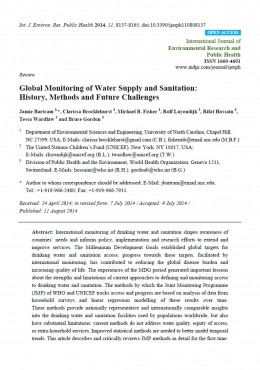RWSN Library

Author
Bartram J., Brocklehurst C., Fisher M.B., Luyendijk R., Hossain R., Wardlaw T., Gordon B.
Year of Publishing
2014
Publisher
Institution
UNC, UNICEF, WHO
Global Monitoring of Water Supply and Sanitation: History, Methods and Future Challenges
Description:
International monitoring of drinking water and sanitation shapes awareness of countries‘ needs and informs policy, implementation and research efforts to extend and improve services. The Millennium Development Goals established global targets for drinking water and sanitation access; progress towards these targets, facilitated by international monitoring, has contributed to reducing the global disease burden and increasing quality of life. The experiences of the MDG period generated important lessons about the strengths and limitations of current approaches to defining and monitoring access to drinking water and sanitation. The methods by which the Joint Monitoring Programme (JMP) of WHO and UNICEF tracks access and progress are based on analysis of data from household surveys and linear regression modelling of these results over time. These methods provide nationally representative and internationally comparable insights into the drinking water and sanitation facilities used by populations worldwide, but also have substantial limitations: current methods do not address water quality, equity of access, or extra-household services. Improved statistical methods are needed to better model temporal trends. This article describes and critically reviews JMP methods in detail for the first time.
Bibliographical Information:
Bartram J., Brocklehurst C., Fisher M.B., Luyendijk R., Hossain R., Wardlaw T., Gordon B. (2014) Global Monitoring of Water Supply and Sanitation: History, Methods and Future Challenges. , UNC, UNICEF, WHO
DOWNLOADS (32)
Global Monitoring of Water Supply and Sanitation: History, Methods and Future Challenges
 Google Übersetzer
Google Übersetzer
